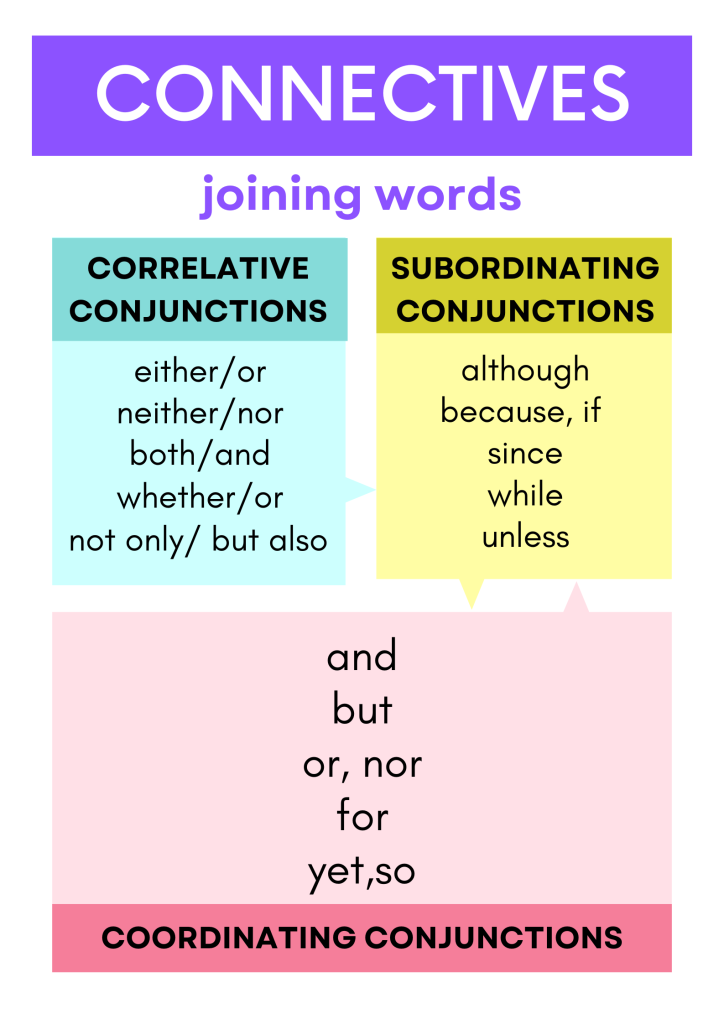What are Conjunctions? – Meaning and Examples
Table of Contents
Introduction
Conjunctions
Conjunctions are an essential part of English grammar, serving as the glue that holds different parts of a sentence together. They are words that connect words, phrases, or clauses, allowing for the creation of complex and meaningful sentences. In this article, we will explore the different types of conjunctions and how to use them effectively in writing and communication.
Analogy of Definition
What are Conjunctions?
Conjunctions are words used to join words, phrases, or clauses. They are crucial for creating compound and complex sentences, as they establish relationships between different elements of a sentence. There are three main types of conjunctions: coordinating conjunctions, correlative conjunctions, and subordinating conjunctions. It is one of the eight parts of speech.
Method
Using Conjunctions
Coordinating Conjunctions: These conjunctions include words like “and,” “but,” “or,” “nor,” “for,” “yet,” and “so.” They are used to join words, phrases, or independent clauses of equal importance within a sentence.
Correlative Conjunctions: These conjunctions come in pairs, such as “either/or,” “neither/nor,” “both/and,” “not only/but also,” and “whether/or.” They are used to link equivalent sentence elements.
Subordinating Conjunctions: These conjunctions, such as “although,” “because,” “if,” “since,” “unless,” and “while,” are used to introduce dependent clauses and establish a relationship between the dependent clause and the rest of the sentence.

Learn more about the conjunctions and parts of speech on our site, ChimpVine.
Examples
Using Coordinating Conjunctions
Example 1: I wanted to go to the party, but I had too much work to do.
Example 2: She is smart and hardworking.
Using Correlative Conjunctions
Example 1: Either you come with us, or you stay at home.
Example 2: Not only did she win the race, but she also broke the record.
Using Subordinating Conjunctions
Example 1: Because it was raining, we decided to stay indoors.
Example 2: I will go for a walk if the weather is nice.
Quiz
Tips and Tricks
1. Using Coordinating Conjunctions
Tip: Coordinating conjunctions are used to join words, phrases, or independent clauses of equal importance within a sentence.
2. Using Correlative Conjunctions
Tip: Correlative conjunctions come in pairs and are used to link equivalent sentence elements.
3. Using Subordinating Conjunctions
Tip: Subordinating conjunctions are used to introduce dependent clauses and establish a relationship between the dependent clause and the rest of the sentence.
4. Using Conjunctions in Writing
Tip: When writing, use conjunctions to create complex and meaningful sentences that convey relationships between different elements.
5. Punctuation with Conjunctions
Tip: When using coordinating conjunctions to join independent clauses, use a comma before the conjunction to separate the clauses.
Real life application
Story: “The Adventure of Sarah and Tom”
Sarah and Tom were two friends who embarked on an adventure that required them to use conjunctions in various real-life scenarios.
Scenario 1: The Travel Dilemma
Sarah and Tom were planning a trip, but they couldn’t decide whether to go to the beach or the mountains. They used the correlative conjunction “either/or” to express their dilemma and eventually decided to visit the mountains.
Scenario 2: The Job Interview
During a job interview, Sarah was asked about her strengths and weaknesses. She used the coordinating conjunction “but” to express her strengths and weaknesses in a balanced manner, leaving a positive impression on the interviewer.
Scenario 3: The Cooking Challenge
Tom wanted to cook a special dinner for Sarah, so he decided to make both pasta and salad. He used the coordinating conjunction “and” to express his plan and successfully prepared a delicious meal.
Scenario 4: The Decision-Making Process
Sarah and Tom were faced with a tough decision, but they were determined to make the right choice. They used the coordinating conjunction “yet” to express their determination and eventually made a well-informed decision.
Scenario 5: The Team Project
Sarah and Tom were assigned a team project, and they had to work together to complete it. They used the coordinating conjunction “so” to express the outcome of their collaboration and successfully delivered an impressive presentation.
FAQ's
Like? Share it with your friends

